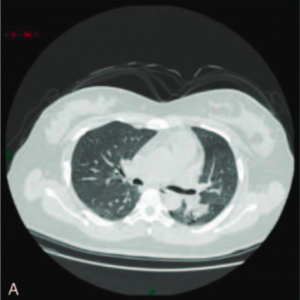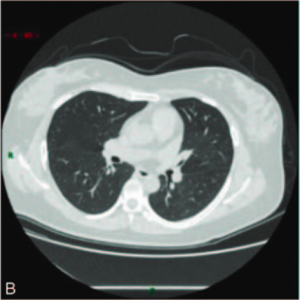This post is adapted for the Health & Medical Case Studies created by the Master of Medical Biotechnology program of the University of Windsor. This work is licensed under a Creative Commons Attribution-NonCommercial (CC BY-NC-ND) 4.0 International License.
35 Case 4-2019: A 33-year-old pregnant woman with pneumonia
“A case report of a pregnant woman infected with coronavirus disease 2019 pneumonia”. (2020).
Peng, J., Li, R., Yin, H., Tang, F., Xie, H., Li, M., & Zhao, Y
Case Summary 1
A 33-year-old pregnant woman was admitted to hospital at her 38+5 weeks of pregnancy with vaginal bleeding. She had a history of contact with COVID-19 case during her second trimester and had symptoms of cough, expectoration and fever. Initially, she was misdiagnosed as common pneumonia and treated accordingly. But later as her symptoms didn’t improve, and the Chest CT showed scattered consolidation and ground glass shadow in both lungs – she was clinically diagnosed with COVID-19 pneumonia during her 30 weeks of gestation and was quarantined. Her condition got improved with nebulization and antibiotic treatment. Later at 34+4 weeks of gestational period, her pharyngeal swab was tested for COVID-19 but came out negative. During her hospital admission on 38+5 weeks, her temperature was 36.4°C, heart rate was 78 bpm, respiratory rate was 20 bpm, blood pressure was 111/61 mmHg with no abnormalities on cardiopulmonary auscultation. She underwent a cesarean section and gave birth to a healthy newborn. COVID-19 Colloidal Gold method for both mother and baby were positive for IgG and negative for IgM and the baby’s pharyngeal swab came out negative. During the hospitalization period, she developed no fever, cough or other symptoms. Five days after cesarean delivery, she was discharged.
Learning Objectives
- Identify the presentations of COVID-19 during pregnancy.
- Investigate and understand the differential diagnosis for COVID-19 pneumonia.
- Discuss the importance of medical imaging investigations for the diagnosis and prognosis of COVID-19 cases.
- Recognize the role of COVID-19 antibody tests along with their interpretation.
Clinical History 1
- Age: 33 years old
- Sex: Female
Medical History 1
- History of contact with diagnosed COVID-19 positive patient during her second trimester (middle phase of pregnancy, 4th to 6th month) on January 23, 2020.
- Record of developing cough and expectoration on January 26 and fever on January 27, 2020, with temperatures fluctuating in between 37.5°C and 37.8°C.
- Common pneumonia was diagnosed, and antibiotics were given for 3days in the community hospital.
- After that, based on the criteria of COVID-19 pneumonia in the New Coronavirus Prevention and Control Program (5th edition), she was diagnosed as a clinically confirmed case of COVID-19, and was quarantined with nebulized inhalation and oral cephalosporin as part of treatment.
- Five days later (30 weeks gestation), her body temperature returned to normal and the symptoms such as cough and expectoration disappeared.
Drug History 1
- History of antibiotics administration (Cephalosporine) during her second trimester.
Obstetric History 1
- L.M.P (first day of last menstrual period) was on July 9, 2019.
- History of smooth uneventful early pregnancy.
- History of one previous cesarean delivery in 2015.
Symptoms 1
- On April 5, 2020, at the gestational age of 38 weeks and 5days, she was admitted to the hospital with complaints of small amount of vaginal bleeding.
Examinations (Clinical Assays/Tests/Imaging) 1
Physical Examination 1
- Temperature: 36.4 °C
- Heart rate: 78 beats per minute.
- Respiratory rate: 20 beats per minute.
- Blood pressure: 111/61 mmHg
- No abnormalities were heard on cardiopulmonary auscultation.
Laboratory Investigations 1
Blood Investigations on January 30, 2020 (29+2 weeks gestation)1:
|
Test |
Result |
|
Hemoglobin |
115 gm/L |
|
White blood cell count |
8.15 x 109/L |
|
Neutrophil ratio |
78.6% |
|
Lymphocyte count |
1.08 x 109/L |
|
Lymphocyte ratio |
13.3% |
|
C-reactive protein |
99.67 mg/L |
|
Influenza A and B virus antigens, |
Negative |
|
Test for Mycoplasma pneumoniae and Chlamydia pneumoniae |
Negative |
Pharyngeal swab test of SARS-CoV-2 1:
- It revealed twice negative at a community hospital on March 5 and March 7, 2020 (34+4 weeks of gestation).
- Again, the repeat tests conducted on April 6, 2020 (the first day after delivery) and April 7, 2020 (the second day after delivery) showed negative SARS-CoV-2 results.
- On April 7, 2020, the pharyngeal swab test for the newborn revealed negative.
Chest Computed Tomography (CT) Scan:
On January 30, 2020 (29+2 weeks of gestation) 1:
- Chest CT showed scattered consolidation and ground-glass shadow of both lungs.

On March 24, 2020 (37 weeks of gestation) 1:
- The pulmonary CT revealed that most of the lung lesions were absorbed.

On April 5, 2020 (38+8 weeks of gestation) 1:
- The pulmonary CT scan revealed further absorption of the lung lesions.

Question & Answers Leading to Diagnosis:
Question 1: Despite being misdiagnosed initially as a common pneumonia case, how was the final diagnosis made in the given case?
Question 2: What could be the differential diagnosis/(s) for COVID-19 pneumonia and how can we differentiate them based on radiology?
Question 3: What are the risks of COVID-19 infection during pregnancy?
** For answers please check the next chapter.
Medical terminology/Abbreviations:
Trimester of pregnancy– A pregnancy is divided into trimesters:
- the first trimester is from week 1 to the end of week 12
- the second trimester is from week 13 to the end of week 26
- the third trimester is from week 27 to the end of the pregnancy.4
Ground-glass opacities – According to Dr. Cortopassi, Ground glass opacities are a pattern that can be seen when the lungs are sick, while normal lung CT scans appear black, an abnormal chest CT with GGOs will show lighter-colored or gray patches. Those lighter patches don’t completely obscure the other structures in the lungs. There is haziness seen overlying an area of the lung, but the underlying structures of the lung (airways, blood vessels, lung tissue) can still be identified. It resembles, ground glass, or glass that is still transparent but has a matte finish.5
- GGOs aren’t specific to COVID-19 and can be seen in so many different settings. GGOs in chest CT scans can also indicate congestive heart failure, inflammatory interstitial lung diseases, and diffuse alveolar hemorrhage (bleeding into the airspaces of the lungs), among other issues. But one of the most common diagnosis for GGOs is viral pneumonias, most often caused by respiratory syncytial virus (RSV), cytomegalovirus, herpes simplex virus, and coronavirus.5
- In terms of COVID-19, Dr. Cortopassi explains GGOs on a CT scan are indicative of COVID-19-related pneumonia, or lung inflammation caused by the viral infection.5
- A study published in the journal Radiology found that, among 51 Chinese patients with confirmed COVID-19 pneumonia, GGOs showed up in the chest CT scans of 77% of patients. And original research from scientists in China, also published in Radiology, found that CT scans were able to find 97% of COVID-19 infections overall, while blood tests were only able to correctly identify 59% of cases.5
References
- Peng, J., Li, R., Yin, H., Tang, F., Xie, H., Li, M., & Zhao, Y. (2020). A case report of a pregnant woman infected with coronavirus disease 2019 pneumonia. Medicine, 99(30), e21335. https://doi.org/10.1097/md.0000000000021335
- Guarnera, A., Podda, P., Santini, E., Paolantonio, P., & Laghi, A. (2021). Differential diagnoses of COVID-19 pneumonia: the current challenge for the radiologist—a pictorial essay. Insights Into Imaging, 12(1). https://doi.org/10.1186/s13244-021-00967-x
- Understand how COVID-19 might affect your pregnancy. Mayo Clinic. (2021). Retrieved 14 July 2021, from https://www.mayoclinic.org/pregnancy-and-covid-19/art-20482639.
- A Week-by-Week Pregnancy Calendar (for Parents) – Nemours KidsHealth. Kidshealth.org. (2021). Retrieved 14 July 2021, from https://kidshealth.org/en/parents/pregnancy-calendar-intro.html#:~:text=A%20pregnancy%20is%20divided%20into,the%20end%20of%20the%20pregnancy.
- How Lung Scans Can Detect Coronavirus in Some Patients. Health.com. (2021). Retrieved 11 June 2021, from https://www.health.com/condition/infectious-diseases/coronavirus/ground-glass-opacities-covid-19.
Creative Commons License
the second trimester is from week 13 to the end of week 26
Cephalosporins are beta-lactam antimicrobials used to manage a wide range of infections from gram-positive and gram-negative bacteria.
Bui T, Preuss CV. Cephalosporins. [Updated 2021 Aug 31]. In: StatPearls [Internet]. Treasure Island (FL): StatPearls Publishing; 2022 Jan-. Available from: https://www.ncbi.nlm.nih.gov/books/NBK551517/


